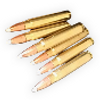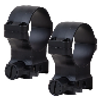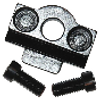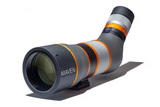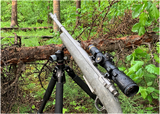I was contacted by a client who wanted to give his bear guide a custom rifle as a tip for the successful bear hunt where he harvested a beautiful 10 ft. 6 in fall brown bear.
As the rifle would only be used when things turned bad the cartridge selected was the .416 Remington to be built on magnum pre-64 Winchester Model 70 action. The action's claw extractor and three-position safety make it an ideal choice for a big game guide's backup rifle in Alaska where pursuing a poorly shot bear into thick cover can be quite dangerous and stressful. Shots in these situations can range from a few feet to a few yards making a scope with quick detachable rings ideal for the optical system.
I designed the barrel with an integral 1/4 rib that would accommodate a mid-rib rear open sight and front sight blade on an integral oval front ramp. The top surface of the quarter rib and the top of the front ramp are located .100 higher than the scope bases on the receiver. A front sight hood was omitted as they tend to collect leaves and small twigs in heavy cover rendering iron sights useless.

An integral sling swivel stud was located 9" back from the muzzle. I incorporated a low oval base to compliment the oval oval theme used to transition the quarter rib and front sight bases into the mid-rib. Although 9" may seem a bit forward for the sling mount, positioned like this keeps the muzzle lower than the hunter's head when slung making it much easier going in heavy cover.

The final design feature of the barrel is an integral recoil lug located 4" forward of the receiver face.
My first and foremost objective for the barrel design was to give the final barrel an eye pleasing complement of the heights and dimensions of the accessories relative to overall dimensions of the barrel. In the end I believe the lines must compliment and not dominate elements of the stock and action.

Programing and design work were done using Mastercam, the machining work being done on my CNC HAAS mill. This allows the complex nature of multiple arcs and ovals to be gracefully merged into the basic solid surfaces of a raw barrel. The design programing on a quality barrel typically takes from 5-7 days and the CNC machine work taking another 5 days.
The CNC work is followed by hours of hand polishing with diemaker's stones and the final finish is brought in with Scotch Brite pads. The Scotch Brite finish gives the metal a beautiful matte finish that quickly exposes the slightest blemishes.
The final polishing must be done carefully and slowly in order to preserve all lines and sharp corners and reach the subtle areas where
Prior to taking the barrel to the milling machine the barrel is chambered and indexed on the receiver to establish the top flat of the rib which makes it possible for the arcs at the rear of the quarter rib to flow cleanly and precisely into the receiver face. I contoured the scope bases for the radius on the front and rear receiver bridges and left the final fitting to the gunmaker that would also stock the rifle. Mathew Roberts of MNR Custom Rifles was that gunmaker and he established the final height of the scope bases and machined the dovetails to accommodate a set of my quick detachable rings.
The stock blank was a very nice piece of Turkish walnut with clean lines through the grip and action areas. In addition to the stock work, Mathew welded on a Mcfarland two panel bolt handle and regulated the sights on a fast turnaround. His work is impeccable and cannot be fully appreciated until you hold one of his stocks on your hands. The finished project pointed like a fine custom fitted shotgun with the shooter's eye naturally finding the sights simply by mounting the rifle. The outcome could not have been more perfect for a dangerous game rifle where close and quick shots are occasionally required. I was honored to present this rifle to its new owner but regretted having to do so.





